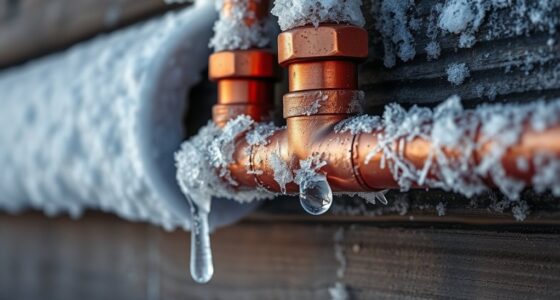Your electrical panel is the control center that distributes power throughout your home, with breakers acting as safety switches. Single-pole breakers handle 120V circuits for outlets and lights, while double-pole breakers manage 240V circuits for appliances. These breakers trip when current exceeds safe levels, preventing overheating and fires. Modern options like GFCIs and AFCIs add extra safety. Keep exploring to learn more about how these components protect your home and family.
Key Takeaways
- Breakers protect electrical circuits by shutting off power when overloaded or faulty, preventing damage and hazards.
- Single-pole breakers handle 120V circuits for outlets and lighting, while double-pole breakers manage 240V appliances.
- Modern breakers include safety features like GFCIs and AFCIs to prevent shocks and detect arcing faults.
- Proper breaker selection ensures system safety, prevents overloads, and supports efficient power distribution.
- Regular inspection and understanding of breaker types are essential for safe maintenance and upgrades of the electrical system.

Have you ever wondered what keeps your home’s electrical system running safely and efficiently? At the heart of it all is your electrical panel, where circuit protection takes center stage. The main purpose of the panel is to distribute electricity throughout your home while safeguarding you from electrical hazards. This is achieved through various breaker types, which are essential components that prevent overloads and short circuits. Breakers act as gatekeepers, automatically shutting off power when they detect something amiss, protecting your wiring, appliances, and even your family.
Your electrical panel’s breakers protect your home from overloads and hazards, ensuring safe and efficient power distribution.
Understanding breaker types is fundamental because each serves a specific function and is designed for different parts of your electrical system. The most common are circuit breakers, which are typically either single-pole or double-pole. Single-pole breakers are used for standard circuits, handling 120 volts, and are responsible for powering outlets, lighting, and smaller appliances. Double-pole breakers, on the other hand, manage 240 volts and are used for higher-demand appliances like ovens, dryers, and air conditioning units. Choosing the right breaker type guarantees your electrical system operates smoothly and safely.
Circuit protection is not just about shutting off power during overloads; it’s about preventing damage and potential fires. Breakers are designed to trip or shut off when they sense current flowing beyond their rated capacity. This quick response helps avoid overheating wires, melting insulation, or sparking. Modern breakers also include features like ground-fault circuit interrupters (GFCIs) and arc-fault circuit interrupters (AFCIs). GFCIs protect against ground faults, which can cause electric shocks, especially in wet areas like kitchens and bathrooms. AFCIs detect arcing faults, which can ignite fires before they start. These advanced breaker types enhance safety by addressing specific hazards that traditional breakers might miss.
When it comes to maintaining your electrical panel, knowing about circuit protection and breaker types empowers you to make informed decisions. Whether you’re upgrading your system or troubleshooting issues, understanding how breakers work helps you identify problems and guarantee your home stays protected. Remember, not all breakers are created equal, and selecting the appropriate type depends on the circuit’s purpose and the appliances connected. Properly rated and functioning breakers are indispensable for safeguarding your home’s electrical infrastructure. Additionally, integrating AI-based safety monitoring can further enhance your home’s electrical safety systems by providing real-time alerts and diagnostics. By understanding these fundamentals, you can appreciate how your electrical panel keeps your household powered safely, efficiently, and ready for any electrical challenge that comes your way.
Frequently Asked Questions
How Often Should Circuit Breakers Be Tested or Replaced?
You should test your circuit breakers annually to guarantee home safety and confirm they trip properly. Replace any breakers that show signs of wear, damage, or don’t reset correctly. Typically, circuit breakers have a lifespan of about 30 to 40 years, but this varies based on usage and environment. Regular inspections and timely replacements help prevent electrical hazards and keep your home safe.
Can I Upgrade My Electrical Panel Myself?
Did you know that nearly 30% of electrical fires start due to improper panel work? Upgrading your electrical panel isn’t a DIY job; it’s best left to licensed electricians. Attempting DIY upgrades risks electrical shock, fire, and code violations. Before starting, verify your panel is properly labeled for safety and future maintenance. Always prioritize safety and professional expertise to protect your home and loved ones.
What Indicates a Faulty Breaker?
You’ll notice a faulty breaker if it keeps tripping frequently or if you see a burning smell near your electrical panel. Tripped breakers indicate an overload or short circuit, while a burning smell signals potential overheating or wiring issues. Never ignore these signs—turn off the power and call a professional electrician promptly to inspect and replace the faulty breaker, ensuring your safety and preventing further damage.
Are There Different Types of Circuit Breakers for Specific Appliances?
Sure, there are different types of circuit breakers designed for specific appliances, even if it seems like overkill. You just need to check appliance compatibility and breaker ratings to make certain of safety and efficiency. For high-power appliances like dryers or ovens, you’ll find dedicated breakers that handle their demands. This way, you avoid overloads and potential hazards, proving that even electrical systems get their own specialized gear for the job.
How Does a GFCI Breaker Differ From a Standard Breaker?
A GFCI breaker differs from a standard breaker by detecting ground faults, which occur when current leaks to the ground, potentially causing electric shocks. It quickly interrupts power, offering ground fault protection, especially in wet areas like kitchens or bathrooms. Unlike standard breakers, some GFCI models also provide surge protection, safeguarding appliances from voltage spikes. This makes GFCI breakers essential for safety and protecting sensitive electronics.
Conclusion
Think of your electrical panel like the heart of your home’s electrical system—pumping power to every room. Just like a heart needs healthy valves to keep blood flowing smoothly, your breakers protect your home from overloads. I once saw a homeowner save hundreds by flipping a breaker instead of calling an electrician for a simple issue. Understanding your panel keeps your home safe and running smoothly, so treat it like your home’s essential organ.









